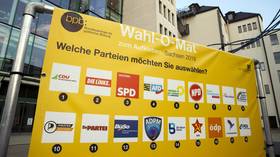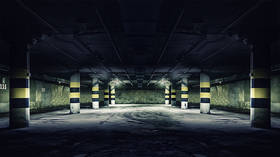Tight election race in Germany’s Saxony & Brandenburg may show AfD is definitely no mayfly

Establishment parties and resurgent right-wingers in two major eastern German states are neck in neck. Sunday’s vote may add to the ongoing plight of mainstream forces while again proving their rival, AfD, is a no mayfly.
Regardless of their eventual results, parliamentary elections in Germany’s Saxony and Brandenburg regions – both parts of former Eastern Germany or DDR – are set to mark quite a milestone. Chancellor Angela Merkel’s Christian Democrats (CDU) and their coalition partners from the Social Democratic Party (SPD) are witnessing unprecedentedly low support in the states that have been their strongholds ever since the reunification of Germany in the early 1990s.
Also on rt.com Germany’s Social Democrats question coalition after leader Nahles resignsThe two “people’s parties” – heavyweights of German politics – are facing fierce competition from the Alternative for Germany (AfD). The latter is a right wing force, which made a name for itself primarily by opposing Merkel’s ‘open doors’ policy and calling for a tougher approach towards immigration and asylum rights.
In Brandenburg, where the Social Democrats have retained their leadership for some 30 years, they are now locked in a tight competition with the AfD, with each party enjoying a roughly equal 21 percent of support. Christian Democrats have been pushed to third place with 17 percent while all the other parties are trailing far behind.
East Germany shows support for right-wing AfD while major parties move to historic low in recent pollshttps://t.co/2H7kSX6TUj
— RT (@RT_com) August 6, 2019
In Saxony, where Merkel’s Party boasted a staggering 60 percent support some two decades ago, its backing now is twice as low, according to the August survey. Moreover, CDU maintains only a seven-percent lead over the AfD. The Social Democrats here are polling just fifth by gaining a mere 8-9 percent of public support, according to the survey results that might be called catastrophic for the party.
With the political landscape fractured and almost all traditional alliances hardly sufficient for forming a parliamentary majority, the two states are likely to witness a great deal of lengthy and uneasy coalition talks.
The Social Democrats are living through arguably the worst popular support crisis in the party’s modern history. Many members blame it on the years-long alliance with Merkel, arguing that the SPD lost its own identity and values it once stood for in the shadow of the coalition’s leading force.
Also on rt.com Merkel successor lashes out against YouTubers over election controversy but CDU problems run deeperThe AfD, at least for now, shows few signs of its political backing fading. The party that primarily capitalized on anti-immigrant sentiments at the height of the 2015 refugee crisis was once considered a dayfly, which would come down together with the immigration tide.
Yet, over the years which saw the flow of new arrivals slowing down, the AfD demonstrated unusual prowess in political survival. It entered all the regional legislatures and even gained some 12 percent of the seats in federal parliament in 2017. Now, it is arguably poised for some record election results in Brandenburg and Saxony. The latter has been known as its “hotbed” for some time.
If you like this story, share it with a friend!














